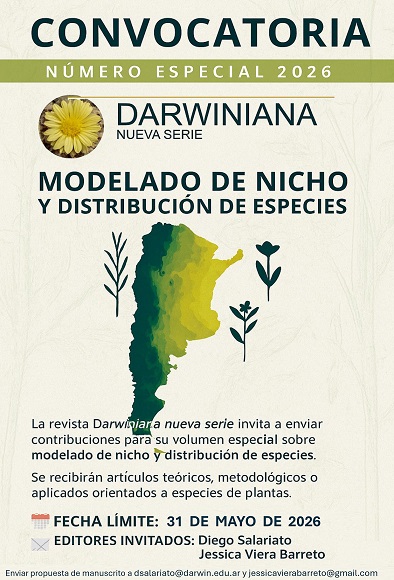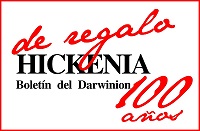Especies de Trichoderma asociadas con nidos de hormigas del género Acromyrmex en Argentina y primer registro de Trichoderma lentiforme para el país
DOI:
https://doi.org/10.14522/darwiniana.2017.51.724Palabras clave:
Ascomycota, hormigas cortadoras de hojas, identificación molecular, identificación morfológica, taxonomía, Tef1.Resumen
Este trabajo tiene como objetivo la identificación morfológica y molecular de cinco especies de Trichoderma asociadas con los nidos de hormigas cortadoras de hojas del género Acromyrmex presentes en Argentina. Las especies identificadas fueron: T. lentiforme, T. inhamatum, T. virens, T. koningiopsis y T. aff. neotropicale resultando éste el primer registro de T. lentiforme y T. inhamatum asociados a hormigas cortadoras de hojas Acromyrmex, en particular Acromyrmex lobicornis y Acromyrmex lundii para el primero y de A. lobicornis para el segundo. Además T. lentiforme representa el primer registro para la Argentina. En este trabajo se amplían medidas del conidióforo y conidios y se aportan datos adicionales sobre la distribución de las especies de Trichoderma en el país. Se ilustran con fotografías los conidióforos, células conidiógenas, conidios y el fenotipo de la colonia para cada especie.Citas
Augustin, J. O.; J. Z. Groenewald, R. J. Nascimento, E. S. Mizubuti, R. W. Barreto, S. L. Elliot & H. C. Evans. 2013. Yet more weeds in the garden: fungal novelties from nests of leaf-cutting ants. PLoS ONE 8: 1-17.
Barrera, V. 2012. El género Hypocrea Fr. (Hypocreales, Ascomycota) en la Argentina. Estudio de la variabilidad molecular de su estado anamórfico Trichoderma. Tesis Doctoral. Facultad de Ciencias Exactas y Naturales. Universidad de Buenos Aires, P 241.
Carreiro, S. C.; F. C. Pagnocca, O. C. Bueno, M. B. Júnior, M. J. A. Hebling & O. A. da Silva. 1997. Yeasts associated with nests of the leaf-cutting ant Atta sexdens rubropilosa Forel, 1908. Antonie van Leeuwenhoek 71: 243-248.
Chaverri, P.; G. J. Samuels & E. L. Stewart. 2001. Hypocrea virens sp. nov., the teleomorph of Trichoderma virens. Mycologia 93: 1113-1124.
Chaverri, P. & G. J. Samuels. 2003. Hypocrea/Trichoderma (Ascomycota, Hypocreales, Hypocreaceae): species with green ascospores. Studies in Mycology 48: 1-116.
Chaverri, P.; F. Branco-Rocha, W. Jaklitsch, R. Gazis, T. Degenkolb & G. J. Samuels. 2015. Systematics of the Trichoderma harzianum species complex and the reidentification of commercial biocontrol strains. Mycologia 107: 14-147.
Currie, C. R.; J. A. Scott, R. C. Summerbell & D. Malloch. 1999a. Fungus-growing ants use antibiotic-producing bacteria to control garden parasites. Nature 398: 701-704.
Currie, C. R.; U. G. Mueller & D. Malloch. 1999b. The agricultural pathology of the ant fungus garden. Proceedings of the National Academy of Sciences 96: 7998-8002.
Druzhinina, I. S.; E. Shelest, & C. P. Kubicek. 2011. Novel traits of Trichoderma predicted through the analysis of its secretome. Federation of European Microbiological Societies Microbiology Letters 337: 1-9.
Fisher, P. J; D. J. Stradling, B. C. Sutton & L. E. Petrini. 1996. Microfungi in the fungus gardens of the leaf-cutting ant Atta cephalotes: a preliminary study. Mycological Research 100: 541-546.
Folgarait P.; N. Gorosito, R. Poulsen & C. R. Currie. 2011. Preliminary in vitro insights into the use of natural fungal pathogens of leaf-cutting ants as biocontrol agents. Current Microbiology 63: 250-258.
Goloboff, P. & S. Catalano. 2016. TNT, version 1.5, with a full implementation of phylogenetic morphometrics. Cladistics. DOI: 10.1111/cla.12160
Hölldobler, B. & E. O. Wilson. 1990. The Ants. Cambridge, USA: Belknap Press of Harvard University Press, P 732.
Jaklitsch, W. M. 2009. European species of Hypocrea Part I. The green-spored species. Studies in Mycology 63: 1-91.
Little, A. E.; T. Murakami, U. G. Mueller & C. R. Currie. 2006. Defending against parasites: fungus-growing ants combine specialized behaviors and microbial symbionts to protect their fungus gardens. Biology letters 2: 12-16.
Lugo, M. A.; E. M. Crespo, M. Cafaro & L. Jofré. 2013. Hongos asociados con dos poblaciones de Acromyrmex lobicornis (Formicidae) de San Luis, Argentina. Boletín de la Sociedad Argentina de Botánica 48: 5-15.
Miller, J. H.; J. E. Giddens & A. A. Foster. 1957. A survey of the fungi of forest and cultivated soils of Georgia. Mycologia 49: 779-808.
Möller, A. 1893. Die Pilzgärten einiger südamerikanischer Ameise. Verlag Von Gustav Fischer. P 159.
Montoya, Q. V.; L. A. Meirelles, P. Chaverri & A. Rodrigues. 2016. Unraveling Trichoderma species in the attine ant environment: description of three new taxa. Antonie van Leeuwenhoek 109: 633-651.
Muchovej J.J.; T. M. Della Lucia & R. M. Muchovej. 1991. Leucoagaricus weberi sp. nov. from nest of leaf-cutting ants. Mycological Research 95:1308-1311.
Pagnocca, F. C.; M. Bacci, M. H. Fungaro, O. C. Bueno, M. J. Hebling, A. Sant’Anna & M. Capelari. 2001. RAPD analysis of the sexual state and sterile mycelium of the fungus cultivated by the leaf-cutting ant Acromyrmex hispidus fallax. Mycological Research 105: 173-176.
Pinto-Tomás, A. A.; M. A. Anderson, G. Suen, D. Stevenson, F. S. Chu, W. W. Cleland, P. J. Weimer & C. R. Currie. 2009. Symbiotic nitrogen fixation in the fungus gardens of leaf-cutter ants. Science 326: 1120-1123.
Rambaut, A. & A. J. Drummond. 2007. Tracer 1.4. Available from http://beast.bio.ed.ac.uk/Tracer
Ribeiro, M. M. R.; K. D. Amaral & V. E. Seide. 2012. Diversity of Fungi Associated with Atta bisphaerica (Hymenoptera: Formicidae): The Activity of Aspergillus ochraceus and Beauveria bassiana. Psyche: A Journal of Entomology vol. 2012. P 6.
Rodrigues, A.; M. Jr. Bacci, U. G. Mueller, A. Ortiz & F. C. Pagnocca. 2008. Microfungal weeds in the leafcutter ant symbiosis. Microbial Ecology 56: 604-614.
Rodrigues, A.; F. C. Pagnocca, M. Bacci, M. J. A. Hebling, O. C. Bueno & L. H. Pfenning. 2005. Variability of non-mutualistic filamentous fungi associated with Atta sexdens rubropilosa nests. Folia Microbiologica 50: 421-425.
Ronquist, F. & J. P. Huelsenbeck. 2003. MrBayes 3: Bayesian phylogenetic inference under mixed models. Bioinformatics 19: 1572-1574.
Samuels, G. J. 2006. Trichoderma: Systematics, the Sexual State, and Ecology. Phytopathology 96: 195–206.
Samuels, G. J.; S. L. Dodd, B. S. Lu, O. Petrini, H. J. Schroers & I. S. Druzhinina. 2006. The Trichoderma koningii aggregate species. Studies in Mycology 56: 67-133.
Samuels, G. J. & A. Ismaiel. 2009. Trichoderma evansii and T. lieckfeldtiae: two new T. hamatum-like species. Mycologia 101: 142-156.
Scott, J. J.; K. J. Budsberg, G. Suen, D. L. Wixon, T. C. Balser & C. R. Currie. 2010. Microbial community structure of leaf-cutter ant fungus gardens and refuse dumps. PLoS One vol. 5 (3), e9922.
Silva, A.; A. Rodrigues, M. Jr. Bacci, F. C. Pagnocca & O. C. Bueno. 2006. Susceptibility of the ant-cultivated fungus Leucoagaricus gongylophorus (Agaricales: Basidiomycota) towards microfungi. Mycopathologia 162: 115-119.
Singer, R. 1986. The agaricales in modern taxonomy. 4th edition. Koleltz Scientific Books, Koenigstein. P. 918.
Tamura, K.; G. Stecher, D. Peterson, A. Filipski & S. Kumar. 2013. MEGA6: molecular evolutionary genetics analysis version 6.0. Molecular Biology and Evolution 30: 2725-2729.
Veerkamp, J. & W. Gams. 1983. Los hongos de Colombia VIII. Some new species of soil fungi from Colombia. Caldasia 13: 709-717.
Weber, N. A. 1972. The fungus-culturing behavior of ants. American Zoologist 12: 577-587.
Descargas
Publicado
Cómo citar
Número
Sección
Licencia

A partir de 2012, esta obra está licenciada bajo una Licencia Creative Commons Atribución-NoComercial 2.5 Argentina .
Cualquier obra derivada deberá estar previamente autorizada con nota escrita de los editores.








